Class 10th Science - Heredity and Evolution Case Study Questions and Answers 2022 - 2023
By QB365 on 09 Sep, 2022
QB365 provides a detailed and simple solution for every Possible Case Study Questions in Class 10th Science Subject - Heredity and Evolution, CBSE. It will help Students to get more practice questions, Students can Practice these question papers in addition to score best marks.
QB365 - Question Bank Software
Heredity and Evolution Case Study Questions With Answer Key
10th Standard CBSE
-
Reg.No. :
Science
-
Sex determination is the method by which distinction between males and females is established in a species. The sex of an individual is determined by specific chromosomes. These chromosomes are called sex chromosomes or allosomes. X and Y chromosomes are called sex chromosomes. The normal chromosomes other than the sex chromosomes of an individual are known as autosomes.
(i) In XX-XO type of sex determination
(a) females produce two different types of gametes
(b) males produce two different types of gametes
(c) females produce gametes with Y chromosome
(d) males produce gametes with Y chromosome.
(ii) A couple has six daughters. What is the possibility of their having a girl next time?(a) 10% (b) 50% (c) 90% (d) 100% (iii) Number of autosomes present in liver cells of a human female is
(a) 22 autosomes (b) 22 pairs (c) 23 autosomes (d) 23 pairs. (iv) XX-XO type of sex determination and XX-XY type of sex determination are the examples of
(a) male heterogamety (b) female heterogamety (c) male homogamety (d) both (b) and (c). (v) Select the incorrect statement.
(a) In male grasshoppers, 50% of sperms have no sex chromosome
(b) Female fruitfly is heterogametic
(c) Human male produces two types of sperms 50% having X chromosome and 50% having Y chromosomes
(d) In turtle, sex determination is regulated by environmental factors.(a) -
Gregor Mendel conducted hybridisation experiments on garden peas for seven years and proposed the laws of inheritance in living organisms. He investigated characters in the garden pea plant that were manifested as two opposing traits, e.g., tall or dwarf plants, yellow and green seeds, etc.
(i) Among the seven pairs of contrasting traits in pea plant as studied by Mendel, the number of traits related
to flower, pod and seed respectively were(a) 2,2,2 (b) 2,2,1 (c) 1,2,2 (d) 1,1,2. (ii) The colour based contrasting traits in seven contrasting pairs, studied by Mendel in pea plant were
(a) 1 (b) 2 (c) 3 (d) 4. (iii) Refer to the given table of contrasting traits in pea plants studied by Mendel.
Character Dominant trait Recessive trait (i) Seed colour 

(ii) Flower colour 

(iii) Pod shape 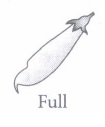
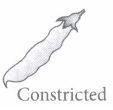
(iv) Flower position 
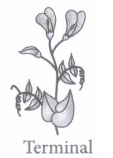
Which of the given traits is correctly placed?
(a) (i), (ii) and (iii) only
(b) (ii), (iii) and (iv) only
(c) (ii) and (iii) only
(d) (i), (ii), (iii) and (iv)
(iv) Some of the dominant traits studied by Mendel were
(a) round seed shape, green seed colour and axial flower position
(b) terminal flower position, green pod colour and inflated pod shape
(c) violet flower colour, green pod colour and round seed shape
(d) wrinkled seed shape, yellow pod colour and axial flower position.
(v) Which of the following characters was not chosen by Mendel?(a) Pod shape (b) Pod colour (c) Position of flower (d) Position of pod (a) -
Mendel crossed tall and dwarf pea plants to study the inheritance of one gene. He collected the seeds produced as a result of this cross and grew them to generate plants of the first hybrid generation which is called the first filial progeny or F1: Mendel then self pollinated the tall F1 plants and he obtained F2 generation.
(i) In garden pea, round shape of seeds is dominant over wrinkled shape. A pea plant heterozygous for round shape of seed is selfed and 1600 seeds produced during the cross are subsequently germinated. How many seedlings would have non-parental phenotype?(a) 1600 (b) 1200 (c) 400 (d) 800 (ii) If 'A' represents the dominant gene and 'a' represents its recessive allele, which of the following would be the most likely result in the first generation offspring when Aa is crossed with aa ?
(a) All will exhibit dominant phenotype.
(b) All will exhibit recessive phenotype.
(c) Dominant and recessive phenotypes will be 50% each.
(d) Dominant phenotype will be 75%.
(iii) Which of the following crosses will give tall and dwarf pea plants in same proportions?A) 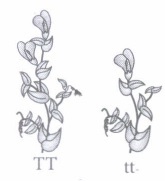
B) 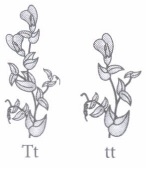
c) 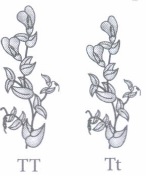
D) 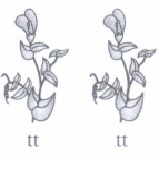
(iv) What result Mendel would have got, if he self pollinated a homozygous tall F2 plant?
(a) TT and Tt
(b) All Tt
(c) All TT
(d) All tt
(v) In plant, tall phenotype is dominant over dwarf phenotype, and the alleles are designated as T and t, respectively. Upon crossing one tall and one dwarf plant, total 250 plants were obtained, out of which 124 displayed tall phenotype and rest were dwarf. Thus, the genotype of the parent plants were
(a) TT x TT
(b) TT x tt
(c) Tt x Tt
d) Tt x tt.(a) -
The cross that include the inheritance of two pairs of contrasting characters simultaneously is referred as dihybrid cross. Mendel chose pure breeding plants for yellow and green seeds and round and wrinkled shape of seeds. He cross pollinated the plant having yellow round seeds with plant having green wrinkled seeds. All the plants produced in F1 generation were having, yellow round seeds. The plants raised from these seeds were self pollinated, that resulted in production of plants having four phenotypically different types of seeds.
(i) When a cross is made between a yellow round seeded plant (YyRr) and a yellow wrinkled seeded plant (Yyrr), what is true regarding the proportions of phenotypes of the offsprings in F1 generation?Proportion of yellow wrinkled seeds Proportion of green wrinkled seeds (a) 3/8 1/8 (b) 2/8 1/8 (c) 1/8 3/8 (d) 2/8 2/8 (ii) How many types of gametes can be produced by YYrr?
(a) 1 (b) 2 (c) 3 (d) 4 (iii) In Mendelian dihybrid cross, when heterozygous tall plant with green seeds are self crossed the progenies are
(a) TtYy, TtYY, TTYy (b) Ttyy, TTyy, ttyy (c) ttYy, ttyy (d) Ttyy, TTyy (iv) When round yellow seeded heterozygous pea plants are self fertilised, the frequency of occurrence of RrYY genotype among the offsprings is
(a) 9/16 (b) 3/16 (c) 2/16 (d) 1/16. (v) The percentage of yr gamete produced by YyRr parent will be
(a) 25% (b) 50% (c) 75% (d) 12.5%. (a) -
In human, the allele for brown eyes (B) is dominant over that for blue eyes (b). A brown eyed woman marries a blue eyed man, and they have six children. Four of the children are brown eyed and two of them are blue eyed.
(i) What is the genotype of blue eyed offspring?(a) BB (b) Bb (c) bb (d) Cannot be determined (ii) What is the woman's genotype?
(a) BB (b) Bb (c) bb (d) Cannot be determined (iii) The ovum, produced by the mother carries the gene regarding eye colour is
(a) BB (b) Bb (c) B or b (d) B only. (iv) The ratio of brown eyed children to blue eyed children in this family is 2 : 1, which deviates from typical phenotypic ratios for monohybrid inheritance. What might be the reason?
(a) Gametes carrying the brown eyed allele are more viable then those with the blue eyed allele.
(b) A different pattern of inheritance other than monohybrid inheritance is involved.
(c) Not all of their babies survived childbirth, thus causing a distortion in the actual ratio.
(d) The actual ratio differs from the expected ratio because the sample size is too small.
(v) What is the gene carried by of the man's sperm regarding the eye colour?(a) BB (b) Bb (c) b only (d) b or B. (a) -
Purebred pea plant with smooth seeds (dominated characteristic) were crossed with purebred pea plant with wrinkled seeds (recessive characteristic). The F1 generation was self pollinated to give rise to the F2 generation.
(i) What is the expected observation of the F1 generation of plants?
(a) 1/2 of them have smooth seeds and 1/2 of the have wrinkled seeds.
(b) 1/4 of them have wrinkled seeds and 3/4 of them have smooth seeds.
(c) 3/4 of them have wrinkled seeds and 1/4 of them have smooth seeds.
(d) All of them have smooth seeds.
(ii) What is the expected observation of the F2 generation of plants?
(a) 1/2 of them have smooth seeds and 1/2 of them have wrinkled seeds.
(b) 1/4 of them have wrinkled seeds and 3/4 of them have smooth seeds.
(c) 3/4 of them have wrinkled seeds and 1/4 of them have smooth seeds.
(d) All of them have smooth seeds.
(iii) If a genotype consists of different types of alleles, it is called(a) homozygous (b) heterozygous (c) monoallelic (d) uniallelic (iv) The alternative form of gene is called
(a) dominant character (b) recessive character (c) alternative genes (d) allele. (v) Which of the following will be the genotypic ratio of given F2 generation?
(a) 1: 3 (b) 3: 1 (c) 1: 2 : 1 (d) 1: 1 : 1 (a) -
In fruittlies, the gene for wing shape has two alleles, an unusual allele for curled wings (c) and the normal allele for straight wings (C). The given phenotypes are observed for each genotype.
Genotype Phenotype CC Normal, straight wings Cc Wings curled up at the ends, has difficulty flying cc Unable to hatch from egg (i) Which of the following crosses would produce live offspring from 50% of the eggs?
(a) CC x Cc (b) CC x CC (c) CC x cc (d) Cc x cc (i) (d)
(ii) (a)
(iii) (a): 25% of the total number of eggs will not
hatch (genotype cc). 50% of the offspring will be curlywinged
(Cc) and 25% of the offspring are straightwinged
(CC).
(iv) (c)
(v) (b)(ii) Which of the following crosses would be able to produce offspring that would fly normally from 50% of the egg?
(a) CC x Cc (b) Cc x Cc (c) CC x cc (d) Cc x cc (iii) Two curly winged flies are crossed, and they produce 150 eggs. What is the proportion of straight-winged flies expected among the live offspring?
(a) 25% (b) 33% (c) 50% (d) 75% (iv) Normal straight winged flies are self crossed and they produce 120 eggs. What is the proportion of curly winged flies expected among the live offspring?
(a) 25% (b) 75% (c) 0% (d) 100% (v) Which of the following crosses would be able to produce offspring that has curled wings only?
(a) CC x Cc (b) CC x cc (c) Cc x Cc (d) Cc x cc (a) -
Refer to the schematic representation of the albinism that is an inherited condition caused by recessive allele (a). 'A' is the dominant allele for the normal condition. The inheritance of certain genetic traits for two or more generations is represented in a pedigree or family tree. Study the given pedigree chart and answer the following questions.
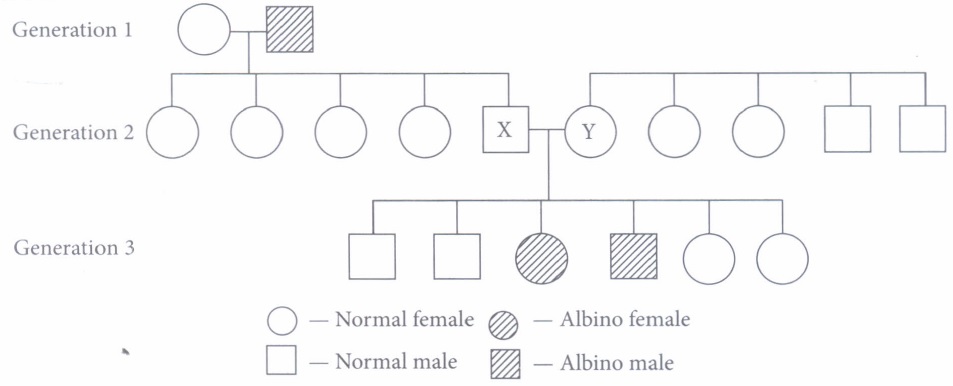
(i) Which of the following could be the genotypes of X and Y?X Y (a) AA AA (b) AA Aa (c) Aa Aa (d) aa aa (ii) Which of the following could be the genotype of generation - 1 male and female?
Male Female (a) AA aa (b) aa AA (c) Aa aa (d) AA AA (iii) If X married an albino female, then what is the probability that their children would be albino?
(a) 0 (b) 0.125 (c) 0.25 (d) 0.5 (iv) If Y married a normal homozygous male, then what is the probability that their children would be albino?
(a) 0 (b) 0.125 (c) 0.25 (d) 0.5 (v) Which of the following could be the genotype of offsprings produced by cross of X and Y?
(a) AA, Aa, aa (b) aa, aa (c) Aa, Aa (d) AA, AA (a) -
Refer to the given table regarding results of F2 generation of Mendelian cross.
Plants with round and yellow coloured seeds (P) 315 Plants with round and green coloured seeds (Q) 108 Plants with wrinkled and yellow coloured seeds (R) 101 Plants with wrinkled and green coloured seeds (S) 32 (i) Which of the following would be the phenotype of F1 generation regarding given data of F2 generation?
(a) Plants with round and yellow coloured seeds
(b) Plants with round and green coloured seeds
(c) Plants with wrinkled and yellow coloured seeds
(d) Plants with wrinkled and green coloured seeds.
(ii) Which of the following would be the genotype of parental generation regarding given result of F2 generation?(a) YYRR and yyrr (b) YYRR and YYRR (c) YYRR and YyRr (d) YyRr and YyRr (iii) If plant with wrinkled and green coloured seeds (S) is crossed with plant having wrinkled and yellow coloured seeds (R), what will be the probable phenotype of offsprings?
(a) All plants with wrinkled and yellow coloured seeds
(b) 50% plants with wrinkled and yellow coloured seeds and 50% plants with wrinkled and green coloured seeds
(c) All plants with wrinkled and green coloured seeds
(d) Both (a) and (b).
(iv) Which of the following will result when plant YyRr is self-pollinated?
(a) 9: 3 : 3 : 1 ratio of phenotypes only
(b) 9: 3 : 3 : 1 ratio of genotypes only
(c) 1-: 1 : 1 : 1 ratio of phenotypes only
(d) 1: 1 : 1 : 1 ratio of phenotypes and genotypes
(v) The percentage of yR gamete produced by YyRR parent will be(a) 25% (b) 50% (c) 75% (d) 12.5% (a) -
Pea plants can have smooth seeds or wrinkled seeds. One of the phenotypes is completely dominant over the other. A farmer decides to pollinate one flower of a plant with smooth seeds using pollen from plant with wrinkled seeds. The resulting pea pod has all smooth seeds.
(i) Which of the following conclusions can be drawn?
1. The allele for smooth seeds is dominated over that of wrinkled seeds.
2. The plant with smooth seeds is heterozygous.
3. The plant with wrinkled seeds is homozygous.(a) 1 only (b) 1 and 2 only (c) 1 and 3 only (d) 1, 2 and 3 (ii) Which of the following crosses will give smooth and wrinkled seeds in same proportion?
(a) RR x rr (b) Rr x rr (c) RR x Rr (d) rr x rr (iii) Which of the following cross can be used to determine the genotype of a plant with dominant phenotype?
(a) RR x RR (b) Rr x Rr (c) Rr x RR (d) RR x rr (iv) On crossing of two heterozygous smooth seeded plants (Rr), a total of 1000 plants were obtained in F1 generation. What will be the respective number of smooth and wrinkled seeds obtained in F1 generation?
(a) 750,250 (b) 500,500 (c) 800,200 (d) 950,50 (v) The characters which appear in the first filial generation are called
(a) recessive characters (b) dominant characters (c) lethal characters (d) non-mendelian characters (a)
Case Study
*****************************************
Answers
Heredity and Evolution Case Study Questions With Answer Key Answer Keys
-
(i) (b) : In XX-XO type and XX-XY type of sex determining mechanisms, males produce two different types of gametes, either with or without X-chromosome (XO type), or some gametes with X-chromosome and some with Y-chromosome (XY type). Such type of sex determination mechanism is designated to be the example of male heterogamety. In both, females are homogametic and produce X type of gametes in both the cases and have XX genotype.
(ii) (b): The possibility of having a girl or boy child is equal i.e., 50%, as 50% male gametes are Y type and 50% are X type. Fusion of egg with X type sperm will produce a girl child.
(iii) (b): In humans, number of autosomes are 2n = 44 or 22 pairs regardless of the sex.
(iv) (a): In XX-XO type and XX-XY type of sex determining mechanisms, males produce two different types of gametes, either with or without X-chromosome (XO type), or some gametes with X-chromosome and some with Y-chromosome (XY type). Such type of sex determination mechanism is designated to be the example of male heterogamety. In both, females are homogametic and produce X type of gametes in both the cases and have XX genotype.
(v) (b): Male fruitfly is heterogametic whereas female fruitfly is homogametic. -
(i) (a): Characters studied by Mendel are as follows:
Trait studied Dominant Recessive 1 Plant height Tall (T) Dwarf (t) 2 Flower position Axial (A) Terminal (a) 3 Flower colour Violet (V) or (W) White (v) or (w) 4 Pod shape Full or Inflated (I) or (C) Constricted (i) or (c) 5 Pod colour Green (G) or (Y) Yellow (g) or (y)
6 Seed shape Round (R) or (W) Wrinkled (r) or (w) 7 Seed colour Yellow (Y) or (G) Green (y) or (g) (ii) (c)
Trait studied Dominant Recessive 1 Plant height Tall (T) Dwarf (t) 2 Flower position Axial (A) Terminal (a) 3 Flower colour Violet (V) or (W) White (v) or (w) 4 Pod shape Full or Inflated (I) or (C) Constricted (i) or (c) 5 Pod colour Green (G) or (Y) Yellow (g) or (y)
6 Seed shape Round (R) or (W) Wrinkled (r) or (w) 7 Seed colour Yellow (Y) or (G) Green (y) or (g) (iii) (d)
Trait studied Dominant Recessive 1 Plant height Tall (T) Dwarf (t) 2 Flower position Axial (A) Terminal (a) 3 Flower colour Violet (V) or (W) White (v) or (w) 4 Pod shape Full or Inflated (I) or (C) Constricted (i) or (c) 5 Pod colour Green (G) or (Y) Yellow (g) or (y)
6 Seed shape Round (R) or (W) Wrinkled (r) or (w) 7 Seed colour Yellow (Y) or (G) Green (y) or (g) (iv) (c)
Trait studied Dominant Recessive 1 Plant height Tall (T) Dwarf (t) 2 Flower position Axial (A) Terminal (a) 3 Flower colour Violet (V) or (W) White (v) or (w) 4 Pod shape Full or Inflated (I) or (C) Constricted (i) or (c) 5 Pod colour Green (G) or (Y) Yellow (g) or (y)
6 Seed shape Round (R) or (W) Wrinkled (r) or (w) 7 Seed colour Yellow (Y) or (G) Green (y) or (g) (v) (d)
Trait studied Dominant Recessive 1 Plant height Tall (T) Dwarf (t) 2 Flower position Axial (A) Terminal (a) 3 Flower colour Violet (V) or (W) White (v) or (w) 4 Pod shape Full or Inflated (I) or (C) Constricted (i) or (c) 5 Pod colour Green (G) or (Y) Yellow (g) or (y)
6 Seed shape Round (R) or (W) Wrinkled (r) or (w) 7 Seed colour Yellow (Y) or (G) Green (y) or (g) -
(i) (c): Since this pea plant is heterozygous for round shape, its genotype would be Rr.

Phenotypically, the ratio will be 3 : 1, i.e., only rr seedlings will show wrinkled seed phenotype, rest will show round seed shape.
1200 \(\Rightarrow\) Round shape (RR, Rr)
400 \(\Rightarrow\) Wrinkled (rr)
(ii) (c): 'A'. represents the dominant gene and 'a' represents its recessive allele. The most likely result in the first generation offspring when Aa is crossed with aa is:

Hence, Aa: aa
1 : 1
(iii) (b): This is an example of a test cross in which a cross is made between heterozygous tall and homozygous dwarf individuals and tall and dwarf plants are obtained in same proportion.
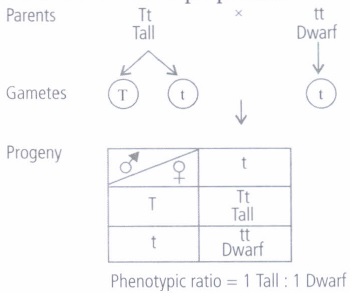
(iv) (c): Self pollination of homozygous tall F2 plant (TT) will give rise to all individuals of genotype TT.
(v) (d) -
(i) (a): A cross between yellow round seeds (YyRr) and yellow wrinkled seeds (Yyrr) will be:

Progenies :
Yr yr YR YYRr
Yellow roundYyRr
Yellow roundYr YYrr
Yellow wrinkledYy rr
Yellow wrinkledyR YyRr
Yellow roundyy Rr
Green roundyr Yy rr
Yellow wrinkledyyrr
Green wrinkledPhenotypic ratio is:
Yellow round seeds : Yellow wrinkled seeds: Green round seeds : Green wrinkled seeds: 3: 3: 1: 1 3/8, 3/8, 1/8, 1/8 (ii) (a)
(iii) (b)
(iv) (c): Round yellow heterozygous pea plant may be represented by genotype RrYy. On selfing such plants following results will be obtained.
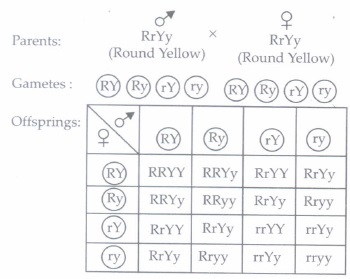
Hence, total 16 genotypes will be obtained in the next generation out of which the frequency of occurrence of RrYY genotype is 2, as illustrated by the given Punnett square chart.
(v) (a): Gametes produced by YyRr parent would be 25% YR, 25% yR, 25% Yr and 25% yr. -
(i) (c)
(ii) (b): According to the given passage some children show recessive trait, i.e., homozygous. So, the woman must be heterozygous.
(iii) (c): Human ova are haploid, hence they only contain one copy of each gene. Since the woman has a Bb genotype her ova would contain either B or b allele.
(iv) (d): According to the given passage, within a single family, the sample size of offspring in each generation is very small. Hence, the actual phenotypic and genotypic ratios often deviate from expected ratios. It is only when sample sizes of offspring is large that actual ratios approach theoretical or expected ratios more closely.
(v) (c): Human sperm is haploid, hence they only contain one copy of each gene. Since the man has a bb genotype, his sperm would contain allele b only. -
(i) (d)
(ii) (b)
(iii) (b): Factors representing the alternate or same form of a character are called alleles. In heterozygous individuals or hybrids, a character is represented by two contrasting alleles. Out of the two contrasting alleles, only one is able to express its effect in the individual. It is called dominant allele. The other allele which does not show its effect in the heterozygous individual is called recessive allele, e.g., in case of hybrid tall pea plants (Tt). 'T' is dominant allele whereas 't' is recessive allele.
(iv) (d): Factors representing the alternate or same form of a character are called alleles. In heterozygous individuals or hybrids, a character is represented by two contrasting alleles. Out of the two contrasting alleles, only one is able to express its effect in the individual. It is called dominant allele. The other allele which does not show its effect in the heterozygous individual is called recessive allele, e.g., in case of hybrid tall pea plants (Tt). 'T' is dominant allele whereas 't' is recessive allele.
(v) (c): In given case, genotypic ratio of F2 progeny will be 1: 2 : 1 where, one is homozygous dominant, two are heterozygous dominant and one is homozygous recessive. -
(i) (d)
(ii) (a)
(iii) (a): 25% of the total number of eggs will not hatch (genotype cc). 50% of the offspring will be curlywinged (Cc) and 25% of the offspring are straightwinged (CC).
(iv) (c)
(v) (b) -
(i) (c): X and Y parents must have 'a' allele (recessive) that is respective for albinism, the genotype of both X and Y individuals would be Aa and Aa as they are normal and 3rd generation, normal and albino male and female is formed in 3 : 1 ratio.
(ii) (b): Albinism is caused by the recessive allele. The children of generation -1, male and female all are normal (Aa). So, in generation-L, the genotype of female must be AA as she is normal and genotype of male is aa as he is albino male.
(iii) (d): Albinism is caused by the recessive allele and father of X is albino male so, the genotype of X is Aa and genotype of albino female is aa. So, the probability that their children would be albino is 50%.
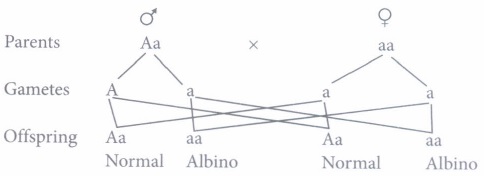
(iv) (a)
(v) (a) -
(i) (a)
(ii) (a)
(iii) (d): Plant with wrinkled and green coloured seeds (S) (genotype rryy) is crossed with plant with wrinkled and yellow coloured seeds (R) (genotype rrYY or rrYr). If plant with wrinkled and green coloured seeds (rryy) is crossed with plant having wrinkled and yellow coloured seeds of genotype rrYY then all plants produced with wrinkled and yellow coloured seeds whereas if plant with wrinkled and green coloured seeds (rryy) is crossed with plant having wrinkled and yellow coloured seeds that has genotype rrYy then 50% plants with wrinkled and yellow coloured seeds and 50% plants with wrinkled and green coloured seeds are produced.
(iv) (a): When plant YyRr is self pollinated, 9: 3 :3 : 1 ratio of phenotypes will be observed. This can be explained as follows:
Parents: \(\begin{array}{ll} \text { YyRr } & \times \quad \text { YyRr } \end{array}\)
Progenies:
YR Yr yR yr YR YYRR
Yellow roundYYRr
Yellow roundYyRR
Yellow roundYyRr
Yellow roundYr YYRr
Yellow roundYYrr
Yellow WrinkledYyRr
Yellow roundYyrr
Yellow WrinkledyR YyRR
Yellow roundYyRr
Yellow roundyyRR
Green roundyyRr
Green roundyr YyRr
Yellow roundYyrr
Yellow WrinkledyyRr
Green roundyyrr
Green WrinkledPhenotypic ratio = 9 yellow and round: 3 yellow and wrinkled: 3 green and round: 1 green and wrinkled.
(v) (b): Gametes produced by YyRR parent would be 50% YR and 50% yR. -
(i) (c)
(ii) (b)
(iii) (d)
(iv) (a): The crossing between two heterozygous smooth seeded (Rr) plants would give phenotypic ratio of 3 smooth seeded plant : 1 wrinkled seeded plant. If plants obtained were 1000, then the number of smooth and wrinkled plants will be closed to 750 and 250 respectively.
(v) (b)
Case Study

























